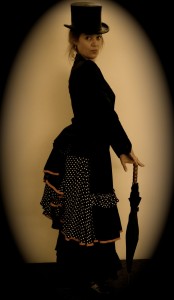08
2013Craftsmanship

My great-great-grandmother wearing my great-great-grandfather’s hat … just kidding, it’s me after a plunge in the dressing up trunk.
As my study got more demanding and it really needed me to focus I curiously got drawn away from it by a strong desire to further professionalize my crafts as a tailor. I never liked to copy anything already existing. Therefore I often altered the original to better meet my taste, running the risk of a complete failure. Of course that happened and I decided to do something about it. Thus I began to take lessons in drawing and designing my own patterns. I learned about forms and proportions and after I had passed my exams I could call myself a certified costumière.
Still a lack of knowledge existed. I wanted to know more about different kinds of textiles and their features. Maybe I would like to have a shop one day, you never know in life. So I managed to get my DETEX diploma. There I learned all about artificial filaments, about twisting and twining, about animal and vegetable fibres, about warp and woof, about woven and knit fabric. As you can see that is very useful knowledge for someone who aims to manufacture durable garments with a perfect fit.
Meanwhile I studied the history of costume. The way people dress really is a mirror of time. It reflects on how active some groups were and how inactive others. It shows the degree of cultural development, the materials and techniques that were available. The female silhouette has changed over and over again and gives enough information to directly point out the period it originates from.
And don’t worry, I nevertheless got my MA after eight years!